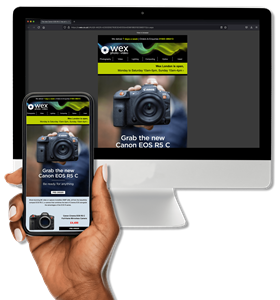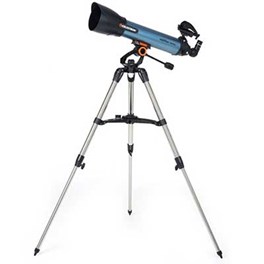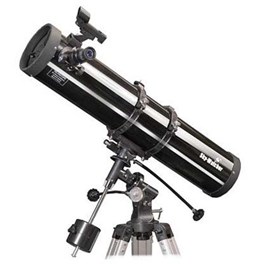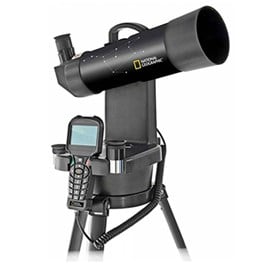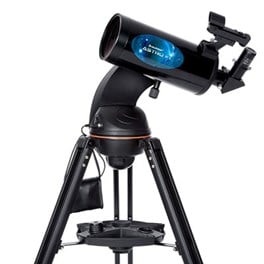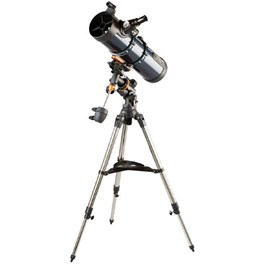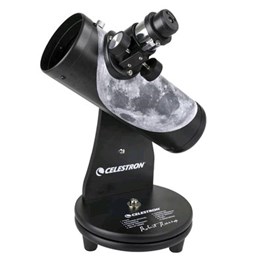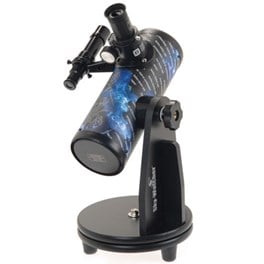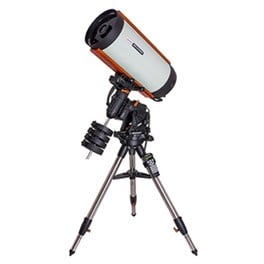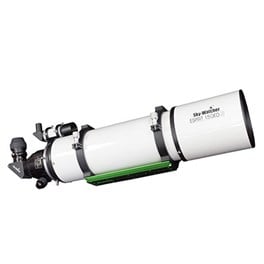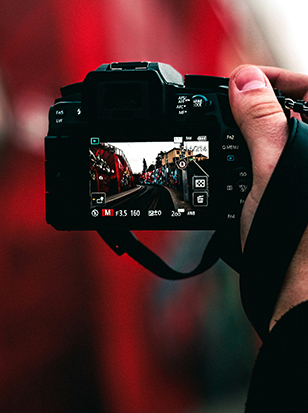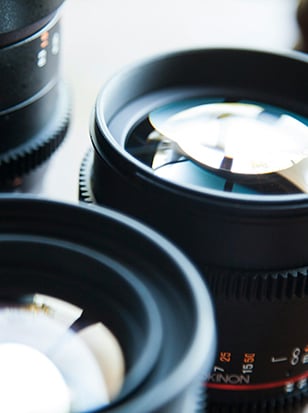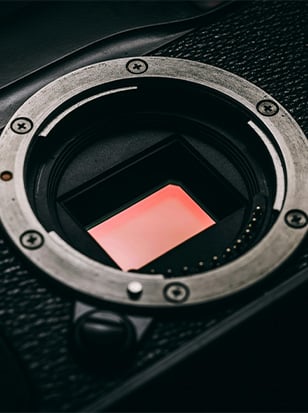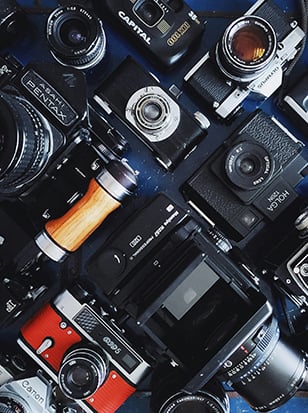
The best telescopes give you access to the beauty of the cosmos. Whether you’re looking to up your game in astrophotography, or just want to get a cool view of the night sky, a good telescope is an inexpensive way to do so. And thanks to modern tech and smartphone integration, finding the objects in the night sky that are worth viewing is easier than it’s ever been.
Telescopes can be intimidating to the layman, but there are loads of great user-friendly options out there designed for those who are new to stargazing. We’ve included plenty of them here, as well as more advanced options for those who are more confident with their star-spotting abilities.
Best Telescope for Beginners
Sky-watching and stargazing are richly satisfying hobbies that provide hours of enjoyment – but like with any similar pursuit, there’s a learning curve. That’s why, if you’re completely new to astronomy, it could make sense to pick up one of the best telescopes for beginners. These scopes are specifically designed to help novices get acclimatised to the basics of viewing the night sky, with app integration and tutorials to help you identify celestial objects, track star patterns, and gain a general overall understanding of what you’re seeing.
Of course, a good beginner’s telescope shouldn’t just be easy to use – it should also offer a genuinely satisfying viewing experience so that you aren’t itching to replace it the moment you’ve mastered the basics. Thus, the telescopes we’ve picked for this category aren’t toys, but offer high enough quality that any novice astronomer will be satisfied with using them for years of happy stargazing.
Pros:
- Interfaces with smartphone for night-sky analysis
- Lightweight, transportable tabletop base
- Good light-gathering ability
Cons:
- Costs more than Inspire 100AZ
Getting to grips with stargazing can be tricky for the novice. The Celestron StarSense Explorer 150 provides a fantastic learning platform with full smartphone integration. Download the StarSense Explorer app to your smart device and you can be identifying night-sky objects within minutes of setting up the tabletop telescope. The ‘scope actually has a dedicated dock for your phone to sit in during use, allowing for true integration between the two. A foolproof interface uses arrows and a bullseye system to guide you towards the objects currently viewable in the sky.
Audio descriptions and step-by-step guides make it easy to get your bearings in the cosmos, and the telescope itself is easy to transport and set up, thanks to the aforementioned tabletop mount that’s easy to balance on any available surface. The 150mm aperture parabolic primary mirror ensures excellent light-gathering ability, meaning you really can pick out the details in celestial objects, from Jupiter’s Great Red Spot to the rings of Saturn.
Pros:
- Loads of included accessories
- Nice big aperture
- Great for celestial and terrestrial viewing
Cons:
- You may want to upgrade the eyepiece
For our money, this is quite simply one of the best telescopes a beginner can buy right now. Well-priced and fully featured, the Celestron Inspire 100AZ Refractor couldn’t be easier to set up. Once you’ve opened the tripod, locked the accessory tray and attached the tube to the base via the quick-release mount, you’re ready to start gazing.
Download the SkyPortal app by Celestron and you’ll have a handy guide at your side to help you orient yourself in the night sky and start finding objects. What’s more, the Celestron Inspire 100AZ comes with a smartphone adapter in the box, so you’ve got everything you need for amateur astrophotography from the get-go. With a nicely large 100mm aperture, this telescope drinks in plenty of light, and if you’re hankering after a sharper image, you can always upgrade the eyepiece to extend the telescope’s lease of life.
Pros:
- Equatorial mount
- Good for near and far objects
- Auto-tracking can be installed
Cons:
- The initial setup can be complex
- Quite a heavy rig
Ideally, the best telescope for beginners should not only be easy to use, but also offer room to grow and develop one’s skills. An excellent choice for just that is the Sky-Watcher Explorer-130 EQ2 Telescope. With a solid EQ2 equatorial mount, it can be easily and smoothly manoeuvered around the night sky for the optimal viewing experience, allowing you to get acclimated with the process of singling out objects in space.
With its solid stability and 360º slow-motion tracking gears on both the right ascension and declination axes, the Sky-Watcher Explorer-130 EQ2 Telescope is equally capable for more experience astronomers, meaning you won’t be desperate to upgrade it within a few months of getting it. There’s also the option to install a D.C. Motor Drive to the R.A. axis, enabling auto-tracking, so you can really grow into the scope and improve as an astronomer.
Best Telescope for Viewing Planets
Viewing the planets in our own solar system – our intergalactic backyard – can be one of the most fun uses of a telescope. It’s a fantastic way to get children involved in learning about astronomy, and the best part is, you don’t need a big and powerful telescope in order to do it. The deserts of Mars, the rings of Saturn, the great Red Spot of Jupiter – all of it can be within easy viewing reach if you have one of the best telescopes for viewing planets.
High magnification is a real advantage for viewing planets, allowing you to get up close and personal with all the details. Many planet-viewing telescopes will also have alignment technology or similar features that help the user find the planets they’re looking for – useful, as not all of our solar neighbours are as easy to spot as the distinctive red Mars. Here, we’ve picked out the best telescopes for spotting every planet in our solar system.
Pros:
- Smooth telescope movement
- Constructed from carbon fibre
- Smartphone adapter included
Cons:
- Aperture on the small side
While it’s something of an all-rounder, the National Geographic 70mm GoTo Refractor Telescope especially shines when used to view the planets of our solar system. Its 70mm aperture and f10 ratio gives it high magnification and a relatively narrow field of view – ideal for getting a closer look at the clouds of Venus or the red tundras of Mars.
The interchangeable Plossl eyepieces give the GoTo Refractor telescope 26.9x to 144x magnification options. As you might expect from something with the National Geographic name, its solid construction suits an outdoor lifestyle. The carbon fibre build means it’s not only tough, but also lightweight, making it easy to transport to different observing locations. This is especially handy if you’re spending your nights tramping up a hill to better see the planets from an elevated position.
An adapter is also included with the telescope, allowing you to connect your smartphone for dazzling planetary photography.
Pros:
- Ultra-light catadioptric design
- Good for beginners
- Optimised for planetary observation
Cons:
- Not built as tough as other scopes
- Image edges a little soft
With fully coated glass optics, the Celestron Astro Fi 102mm Maksutov-Cassegrain Telescope is designed to provide a superlative view of objects in space. Like many other Celestron scopes, it’s compatible with SkyAlign technology, and this means you can plot out exactly where the planets are in the sky at any given time. You can even set yourself up a kind of ‘Sky Tour’, moving in sequence through all the objects that are in your slice of the heavens right now.
The Celestron Astro Fi 102mm Maksutov-Cassegrain Telescope is, for our money, one of the best telescopes you can buy for viewing all our various neighbouring planets. It’s a scope with sophisticated optics and wireless connectivity, giving you all the tools you need for a superb night’s viewing of the planets in our solar system. Its image isn’t as pin-sharp as more expensive telescopes, but for beginners looking to observe the moon and planets, it’s an exemplary choice.
Best Telescope for Astrophotography
Astrophotography is one of the most thrilling disciplines in all of image making. Technically demanding, requiring patience and precision, it’s definitely one for those willing to commit time and energy to their hobby, but those who do so are rewarded with absolutely spectacular imagery.
Of course, even the biggest and most expensive telephoto lens isn’t going to be much good for photographing detailed images of objects in the night sky. For that, you need a telescope. Ideally one that’s compatible with a smartphone or telescope camera adapter, and one that can be mounted and set up to move in the precise way necessary to capture sharp astro images. The movement of the Earth means that a long exposure of the night sky will render it as little more than a blur unless the camera also moves to compensate.
If you’re serious about astrophotography, these are the telescopes we’d recommend.
Pros:
- Exceptionally good optical quality
- Very reliable tracking
- Well-built and durable
Cons:
- Quite heavy
A high-performance alt-azimuth computerized telescope, the Celestron NexStar 6SE Computerised Telescope blends convenient portability with impressive imaging power. All this makes it a terrific choice for photographers.
Use the SkyAlign technology to access the database of more than 40,000 celestial objects, so you always know what you’re looking for and where to look! The optical quality of the scope is fantastic, producing a clear and bright image, and the sturdy steel tripod with accessory tray allows you to make a secure setup for a night’s photography.
You’ll find yourself spoilt for things to photograph once you get the Celestron NexStar 6SE Computerised Telescope up and running, and its sophisticated integrated technology means you can find them quickly and easily.
Pros:
- Motor-driven mount
- High-quality coated optics
- Wide field of view
Cons:
- Equatorial mount tricky for beginners
With its motor-driven equatorial mount, the Celestron Astromaster 130EQ Motorised Reflector Telescope is ideally equipped for capturing long exposures of the night sky. It’s popularly regarded as one of the better beginner scopes out there, but don’t let that fool you – with a wide field of view and all-coated glass optics, it excels at delivering crisp, clear images of celestial objects near and far.
An equatorial mount requires a little more know-how and patience to use than the alt-azimuth type found on the Celestron NexStar 6SE Computerised Telescope. Another thing to be aware of is that the Astromaster 130EQ is a Newtonian reflector telescope, and so will require collimating before use. Once you’ve crossed this rubicon, however, the Astromaster 130EQ is a thoroughly capable telescope, especially for astrophotography. Remember to download the SkyX software as well, as it will help you find and track the objects you want to photograph.
Best Telescope for Kids
Telescopes can be very expensive things, and if your little one has developed an interest in the night sky, you may wince at the prices of some telescopes.
Now, if you outfit something with high-end coated optics and the latest star-tracking computer technology, yes, it’s going to run up quite a significant price tag. However, this doesn’t have to be your only option, and there’s no reason to shut yourself or your child off from stargazing or astrophotography because you’re worried about the cost. There are some fantastic, affordable telescopes out there, including models made by leading brands in the industry, helping you explore the night sky on a budget.
For the best telescopes for kids, we’ve specifically picked telescopes for this section that cost less than £99, but don’t write them off as inferior. Made by leading brands Celestron and Sky-Watcher, these affordable telescopes are constructed with the same care and attention to quality as the bigger models. If you or your kid is looking to try out astronomy without committing too much, one of the telescopes in this section should fit the bill perfectly.
Pros:
- Exceptional value for money
- Solid base
- Wide field of view
Cons:
- Can’t be collimated
While telescopes can be very costly when they’re sophisticated deep-space imaging machines, it’s also possible to get something simple and straightforward for a bargain price. Enter the Celestron FirstScope - Signature Series, a superb imaging scope that you can pick up for an absolute steal. It’s at its best for lunar imaging, and allows you to get superbly detailed images of the moon and its mountains and craters. Happily this isn’t its limit, and you can also use the little scope to spy on Saturn, Venus and the other denizens of our solar system.
With a wide field of view, you can sink yourself into exploring the deep sky, panning across the Milky Way with an eye out for deep-sky objects. The scope was made in conjunction with lunar imager Robert Reeves, and comes with a fair few helpful tips on how to get the best out of your new space-spotting tool.
Pros:
- Rock-solid build
- Intuitive alt-azimuth mount
- Small and very portable
Cons:
- Not the most powerful scope around
This is a special-edition telescope, designed and released to commemorate the 400th anniversary of Galileo’s first telescope. While you might expect it to be a little lacklustre given that fact, the Sky-Watcher Heritage-76 Mini Dobsonian Telescope is anything but that. Lift it out of the box and it’s immediately apparent what a well-built telescope this is. It’s rock-solid, complete with a manually operated Dobsonian alt-azimuth mount, and comes with everything you need to start stargazing.
The 76mm aperture is unremarkable compared to bigger telescopes, but is great for this price, and is more than enough for planetary and even some deep-space observing, which is amazing for a telescope as small as this. If you’re interested in getting kids into astronomy, this approachable but capable scope is one of the finest choices you can make. It’ll sit comfortably on a tabletop, and tuck discreetly out of the way when you’re not using it.
Best Professional Telescope
Finally, we’re rounding out our telescopes guide with the best of the best. If money is no object, size is not a problem, and you want the absolute best scopes for viewing the night sky, we’ve rounded up the best professional telescopes you can buy. These telescopes are ideal for mounting on high-resolution DSLRs or astro-specific CCD cameras, and will capture absolutely dazzling images of deep-space phenomena. An ultra-wide field of view is par for the course, as is premium glass to correct for the slightest aberrations and deliver clean, rich images that are full of extraterrestrial detail.
If you’ve ever looked at high-end, professional astro images and wondered just how on earth the photographer achieved it – this is how. As mentioned, these telescopes aren’t cheap, but they are serious tools for when nothing but the best will do. Even if you aren’t in the market for something so high-end, you have to respect the craftsmanship of these scopes.
Pros:
- Images free from coma and aberrations
- High-end CGX Equatorial Mount
- Tough, precise tripod
Cons:
- Big and hefty
With its f2.2 focus system, 620mm focal length and 279mm, the Celestron CGX 1100 Rowe-Ackermann Schmidt Astrograph Equatorial Telescope is quite simply a cut above the rest. It’s designed for high-end astrophotography, and as such has a mount for a DSLR or CCD camera that can take up to 25kg of weight when used with its mount. The internal optics are constructed from premium coated glass, minimising vignetting and virtually eliminating field curvature and coma aberrations.
The telescope uses a heavy-duty belt-drive system, reducing backlash and providing seamless movement for tracking objects across the sky. There’s a bubble level on the mount to help keep things nice and level. Also included with the mount is the CGX tripod, providing a sturdy steel base on which the telescope can rest and including a latitude scale for polar alignment adjustment.
Pros:
- Precision-corrected optics
- Solid aluminium construction
- Sharp right up to the image edge
Cons:
- Big and heavy
There’s a reason it’s got “professional” in the name – the Sky-Watcher Esprit-150ED Professional Super APO Triplet Refractor OTA is an ultra-high-end, ultra-premium telescope for stargazers and astro imaging. With a three-element objective lens, this telescope delivers absolutely no detectable colour fringing even when focusing on bright objects, resulting in some of the clearest images you can get of the night sky.
Constructed from high-grade aluminium, the Sky-Watcher Esprit-150ED is a solid scope, consisting of high-precision components that move smoothly when adjustments are needed. There’s also a retractable dew shield to protect the telescope in the early hours of the morning. All this adds up to a pretty hefty device, weighing without accessories, but that is something of a necessity for a scope as fully featured as this. Professional astrophotographers will have everything they need here to make absolutely stunning imagery.

How to choose
Telescopes aren’t just for stargazers… No, they can also be used for terrestrial viewing of wildlife and landscapes. Either way, telescopes bring distant objects into close, clear focus. Of course, this brings up a whole host of questions about telescope type, not to mention brands. It’s important to have an understanding of how telescopes work and what they offer. Moreover, it is important to consider what you want from your telescope - are you wanting to look at the moon, or beyond? Do you want complete manual control or a mechanised system that can track and move with the stars themselves? Or, will a terrestrial telescope be an adequate tool for your needs? Overall, there are five key factors to consider: requirements, specifications, aperture, magnification and budget. Let’s cover type the basics first…
The three main types of telescope you’ll be choosing between are as follows:
Refractor telescope - These use a glass objective lens as the key means of collecting light, which is then refracted down a long tube to produce a clear image. They tend to be smaller and more portable than other types, and once they’re set up, are very reliable and will rarely become misaligned. However, just like a photographic lens, they can suffer from chromatic aberration.
Reflector telescope - Reflector telescopes use a series of mirrors in place of a glass lens element to reflect light from the front to the eyepiece. The most common form is a Newtonian reflector, named for scientist Isaac Newton, which uses a dish-shaped primary mirror to collect light. Dobsonian telescopes, a low-cost design allowing for distant observing, are forms of Newtonian reflectors, and are popular with beginners as they provide a lot of viewing power for your money. However, reflector telescopes require regular collimation (mirror alignment) to stay at their best.
Catadioptric telescope - These use both glass lenses and mirrors to create a telescope design that’s extremely transportable, and is a great choice for terrestrial and near-planetary viewing.
Before we get into the list, let’s also quickly look at the key specs you’ll want to consider when buying a telescope.
Aperture - This is the most important aspect of any telescope. The term “aperture” here refers to the diameter of the scope’s key optical component, which as we’ve seen, will be either a lens or a mirror. The larger the diameter (expressed in millimetres), the more light the scope can gather, and the more you can see. Of course, telescopes with larger apertures will by necessity be bulkier, heavier and more expensive
Focal length - This refers to the distance between the main lens or mirror and the image it ultimately produces. A longer focal length narrows the field of view, but increases the magnification. A wide field of view is great for locating and viewing deep-sky objects, while high magnification is great for seeing
Focal ratio - Divide the focal length of a telescope by the aperture value and the result you get is known as the focal ratio. It’s expressed as an f-number – f4, f5, f6.5, etc – and is how you work out what your telescope is best suited for viewing. A telescope with a faster focal ratio, f4 to f5, are good for deep-space viewing as they provide a wide field of view, while slower focal ratios like f11 to f15 are useful for high-power, high-magnification viewing of closer sky objects like the moon.
There’s a lot to it, and don’t worry if you haven’t quite got your head around it – we’ve split our guide up into categories, with telescopes for different users and different use cases. Let’s get into it and start counting up the best telescopes you can buy.
You can also take a look at our astronomy and astrophotography calendar to see when this year's cosmic events should take place!
FAQs
What is a telescope, and how does it work?
A telescope is an instrument that collects and focuses light to magnify distant objects. It works by using lenses or mirrors to gather and bend light, which then travels through the telescope's eyepiece and into the observer's eye.
What are the different types of telescopes?
There are three main types of telescopes: refracting telescopes, reflecting telescopes, and catadioptric telescopes. Refracting telescopes use lenses to focus light, reflecting telescopes use mirrors, and catadioptric telescopes use a combination of lenses and mirrors.
What is aperture, and why is it important?
Aperture refers to the diameter of the telescope's main lens or mirror. The larger the aperture, the more light the telescope can gather, which allows for brighter and sharper images. Aperture is an important factor to consider when choosing a telescope.
Can telescopes be used to view planets and deep-space objects?
Yes, telescopes can be used to view both planets and deep-space objects such as galaxies, nebulae, and star clusters. The type of telescope and its magnification capabilities will determine what can be seen and how clearly.
Do I need a lot of experience to use a telescope?
No, you do not need a lot of experience to use a telescope. However, it is important to read the instructions and become familiar with the telescope's features before use. Practice and patience are key to successfully using a telescope.
Can I use a telescope for astrophotography?
Yes, telescopes can be used for astrophotography, but some telescopes are better suited for it than others. It is important to consider the telescope's aperture, focal length, and tracking capabilities when choosing a telescope for astrophotography.
Do I need to live in a dark sky location to use a telescope?
While living in a dark sky location can enhance your viewing experience, it is not necessary to use a telescope. Light pollution can affect the quality of the images, but with a high-quality telescope and proper filters, you can still view and appreciate celestial objects from a light-polluted area.
Take a look at our telescope category page here!
How do we decide?
Our in-house photography experts, store staff and partners all work collaboratively to pour over our guides and tips articles. We also consider emerging trends and customer feedback to make sure our guides are always up-to-date and reflective of what people are truly looking for. By curating only the best products, our guides provide trustworthy recommendations, making it easier for customers to make informed choices with confidence.
If you would like more advice on any purchase our contact centre staff are here to help. Alternatively, you can reach us via email or social media. And don't forget. If you were to purchase anything based on our recommendations you'll be covered by our full returns policy
The Wex Blog
Sign up for our newsletter today!
- Subscribe for exclusive discounts and special offers
- Receive our monthly content roundups
- Get the latest news and know-how from our experts
